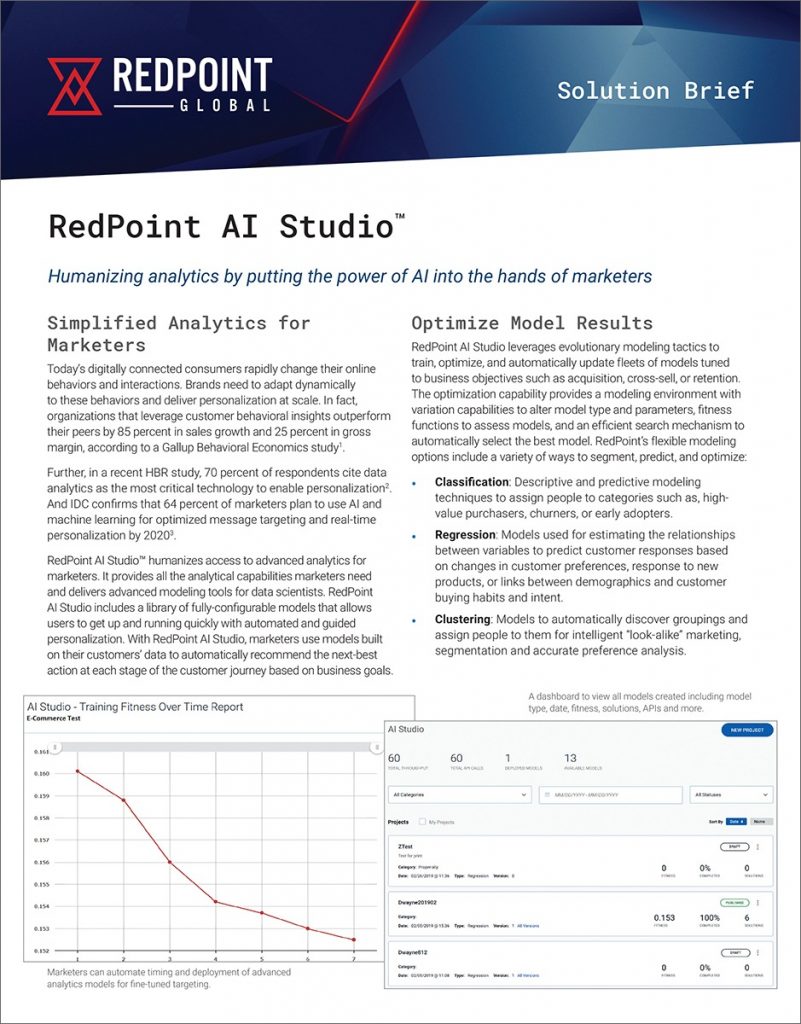 Many companies that use artificial intelligence (AI) to power a business process do so with a “keeping up with the Joneses” philosophy. It’s like buying a 70-inch smart 4K TV because you saw the neighbors bring one home, only to hook it up to your VCR.
Many companies that use artificial intelligence (AI) to power a business process do so with a “keeping up with the Joneses” philosophy. It’s like buying a 70-inch smart 4K TV because you saw the neighbors bring one home, only to hook it up to your VCR.
It’s the same materialism with AI; there’s a notion that modernism in the enterprise requires AI, but there’s less appreciation for its true purpose and potential. The irony is that using AI merely to “keep up” and maybe impress customers or investors is that it devalues a core principle of using analytics and data modeling in the first place, which is to build models that solve for a specific, well-defined business problem. AI’s value does not come from being a status symbol, and to think otherwise runs the risk of relegating the technology to the dustbin of overused, commoditized technologies.
In a previous blog in this space, I wrote about Redpoint’s evolutionary programming modeling and how the automated machine learning models differentiate from everything else in production today. Here, we’ll take a closer look at how the keeping up with the Joneses philosophy is holding companies back from realizing the full potential of advanced analytics, and why it is ultimately costing them revenue.
Not All Machine Learning Models are Built the Same
Redpoint does not, of course, have a monopoly on machine learning models that run through a host of algorithms to determine winners and losers in creating a personalized customer experience. There are other software companies out there trying to optimize a customer experience with models custom built for that purpose and many, to their credit, have the automation part locked down. The difference, though, is that we’re streaming 4K video while the other guys are rewinding a VHS tape.
Code-based, hand-written models are simply not purpose-built for the requirements of a hyper-personalized customer experience, which is 24/7 evolutionary programming that runs without human intervention. The key benefit of Redpoint proprietary automated machine learning models is that data scientists are not a prerequisite; this puts the power of machine learning into marketers, while lights-out models never stop looking for opportunities in a unified customer profile to monetize the data with next-best actions that are perpetually in sync with a customer’s omnichannel buying journey.
There are two reasons why code-based models aren’t up to the task. First, they cannot keep up with today’s always-on, continuously connected customer, who has a countless number of channels and touchpoints with which to interact with a brand, both as an anonymous and known record. When a new channel or new data source emerges and data scientists have to reconfigure their algorithms and build new models, bad things happen. The brand wastes valuable time that would otherwise be spent keeping pace with the customer, and a new model in production loses context of the customer’s overall journey.
Second, code-based, hand-built models fail to meet AI qualification standards. They are built on predictive rules, which are not dynamic and become stale over time. Without an in-line, optimization engine, code-based models require human intervention to refresh, with similar negative results. A dynamic customer journey will always be at least a step ahead of a hand-built model based on a predictive ruleset.
Break Free from Conventional Wisdom, Put the Customer First
With so many drawbacks to relying on code-base models built by data scientists, it begs the question why. Why are companies reluctant to explore the full potential of automated machine learning as the foundation for a mission-critical, revenue-producing engine? Why are they still looking at advanced analytics as a cost center, akin to sinking money on a new TV without a purpose other than to impress the neighbors?
Some of it is a failure of imagination; they’ve yet to formulate a use case for an innovative, hyper-personalized customer experience, or they don’t fully appreciate the significant potential it has to impact the bottom line. According to a Harris Poll survey commissioned by Redpoint, 37 percent of consumers said they will no longer do business with a company that fails to offer a personalized experience, and a majority (63 percent) said that personalization is an expected, standard service.
The other reason is simple stubbornness. For a variety of reasons, many companies just aren’t ready to accept the democratization of access to modeling tools. Perhaps they have a lot of data scientists on staff who for some odd reason seem busier than ever trying to outrace the customer. Perhaps they had great results in the past. Or perhaps they’re just skeptical, thinking that automated machine learning that produces a hyper-personalized customer experience that’s perfectly aligned with a customer journey sounds too good to be true.
If so, prying them from the conventional wisdom will probably take a competitor to lead the way. If they’re not too intractable, it might even be in time to save the business.
RELATED ARTICLES
The Sky is the Limit with AI and Machine Learning: Capitalize on the Moment of Interaction
Harness the Power of Digital Technology as a Revenue-Driving Engine
Beyond the Hype: Put the Power of AI into the Hands of Marketers
Be in-the-know with all the latest customer engagement, data management, and Redpoint Global news by following us on LinkedIn, Twitter, and Facebook.


